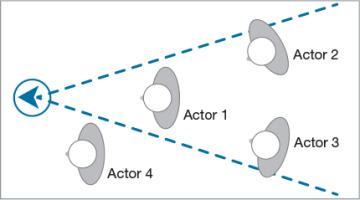- Visual Literacy
- The Six Priorities Determine Where the Eye Looks First
- What Makes an Image Compelling
- Visual Composition Basics
- Blocking: Placing People and Cameras
- Framing and the Rule of Thirds
- Depth of Field
- Does Sex Sell?
- Key Points
- Practice Persuasion
The Six Priorities Determine Where the Eye Looks First
All things being equal, when looking at an image, we look at faces first. But, things are rarely equal, either by accident or by intent. What if there is more than one face in the image? What if there’s only one face but it’s obscured? What if the face is really small? That’s where these priorities come in; they help us guide the viewer’s eye to where we want it to look first.
I’m indebted to Norman Hollyn who first introduced this concept of visual hierarchy to me, though I’ve modified his order and definitions. Our brain is hardwired to process images in a specific order. We will refer to this list often as we create images because it determines the order in which our audience looks at elements within the image. (In fact, for easy reference, you’ll find these listed at the start of each section in this book.)
When looking at still or moving images, such as Figure 2.2, the eye goes through a “checklist” of where to look first, then second, and so on. I call this checklist “The Six Compositional Priorities that Determine Where the Eye Looks First.” That is, ah, a mouthful, so I’ll abbreviate this as the “Six Priorities.” The eye looks at an image and the elements in it in a specific order, based on these priorities:

FIGURE 2.2 Why does your eye see the black puzzle piece first? (Image Credit: pexels.com)
1 |
Movement |
2 |
Focus |
3 |
Difference |
4 |
Brighter |
5 |
Bigger |
6 |
In front |
If something is moving, our eyes look there first. If nothing moves, we look at that which is in focus. If everything is in focus, we look at that which is different. And so on. We look at elements that are higher on this list before we look at elements that are lower. These priorities are not only used for images or video; they also apply to how we look at the world around us in real life.
Let me illustrate each of these.
It is impossible to overemphasize the importance of movement. Long before we learned to write, we were hunters—or being hunted. Our brains are hardwired to pay attention to anything that moves. Our first thought is, “Is that food, or are we food?” Movement always gets our attention.
Obviously, still images don’t “move” as video does. However, we can imply movement, even in a still image. This implied movement often makes for a more compelling image. (When we create video, movement becomes an effective tool for attracting and guiding the eye of the viewer. I’ll cover this in Section 3, “Persuasive Moving Images.”)
Movement is hard to show in a book. For example, if Figure 2.3 were a film, your eye would go first to the lead horse because it is moving and bigger. Here in the book, the image implies movement. A great deal of commercial photography—especially fashion—uses implied movement to attract the eye.

FIGURE 2.3 Movement. The eye is drawn to movement or, in the case of a still image, the illusion of movement. (Image Credit: pexels.com)
Next, our eye goes to that which is in focus. If everything in the image is in focus, which happens with most smartphone shots, the eye skips to the next lower priority. But, if the focus varies within the image, our eye sees the object that is in focus before anything else, other than movement. This is why so many ads and movies present images where only a small portion of the frame is in focus. It tells the eye where it should look first.
Figure 2.4 illustrates this. The frame is filled with people, but we see the laughing woman first because she is the only one in focus.

FIGURE 2.4 Focus. Why does your eye see the smiling woman first? Because focus is more important than brightness or position. (Image Credit: Rene Asmussen / pexels.com)
Next, the eye goes to that which is different. This is why the black puzzle piece in Figure 2.2 attracted your attention. The entire image was white except for that one piece. Different could be a different gender or color or shape or…well, just about anything. Our eye instantly spots something that is out of place, or different, from the surroundings.
In Figure 2.5, you saw the rectangular color palette first because every other shape in the image was either curved or lighter in color. In other words, the simple difference of the color palette was enough to attract our attention first.

FIGURE 2.5 Difference. Your eye went first to the square of colors because it is different, in shape, color, and size, than anything else in the frame. (Image Credit: pexels.com)
Continuing down our list of priorities, if there’s no movement, everything is in focus, and all the elements are similar, our eye goes to that which is brighter. This explains why so many headlines in digital images are white. White attracts the eye, as you can see in Figure 2.6. (So does black against a white background, as in Figure 2.2, but that’s because black is different compared to the white background, and difference ranks higher.)

FIGURE 2.6 Brighter. Your eye went first to the woman on the left, because she is brighter than anything else in the frame.
In fifth position is size; the eye tends to look at the biggest element in the frame first. In Figure 2.7, as the woman looks back at the camera, she is the largest element in the frame. (She is also in focus, which also helps guide the eye.) We see her first and then look over her shoulder into the room to see what the meeting is about.

FIGURE 2.7 Bigger. Your eye went first to the woman on the left, because she is bigger than anything else in the frame. (Image Credit: Elle Hughes / pexels.com)
In the end, if all else is equal, our eye goes to the object in front. In Figure 2.8, all the men are roughly the same height and size. They are all wearing similar clothes. So, where does our eye go first? To the person in the front.

FIGURE 2.8 In front. Your eye went to the man in front. When other criteria are missing, equal or not relevant, your eye goes to the subject in front. (Image Credit: Clarita Alave / pexels.com)
The Six Priorities are really helpful in understanding how to catch and control the eye of the viewer. The eye doesn’t stop exploring an image after its first look; rather, it explores the image based on the Six Priorities. By designing your image and text with these in mind, you can guide the viewer to see what you want them to see in the order you want them to see it.
Elements of the Six Priorities are rarely used by themselves; combining multiple priorities in the same image drives home where the eye needs to look first. We frequently use a “V” shape when positioning (called “blocking”) actors in dramatic or dance scenes, as you can see in Figure 2.9. Positioning the lead actor or singer at the front of the V, combined with a slightly different—and, often, brighter—costume and increased lighting guarantees that the audience will focus on the person the director wants you to watch, in this case, the lead singer.

FIGURE 2.9 These concepts can be combined. Your eye must go first to the woman in front, because she is also brighter and bigger than any other person in the shot. (Image Credit: Cottonbro / pexels.com)
Our number one goal is to capture and retain the eye of the viewer so that we can deliver our message. Applying the Six Priorities can help you better control where the viewer’s eye will look first, then second, and then third as it checks down elements on the list.


